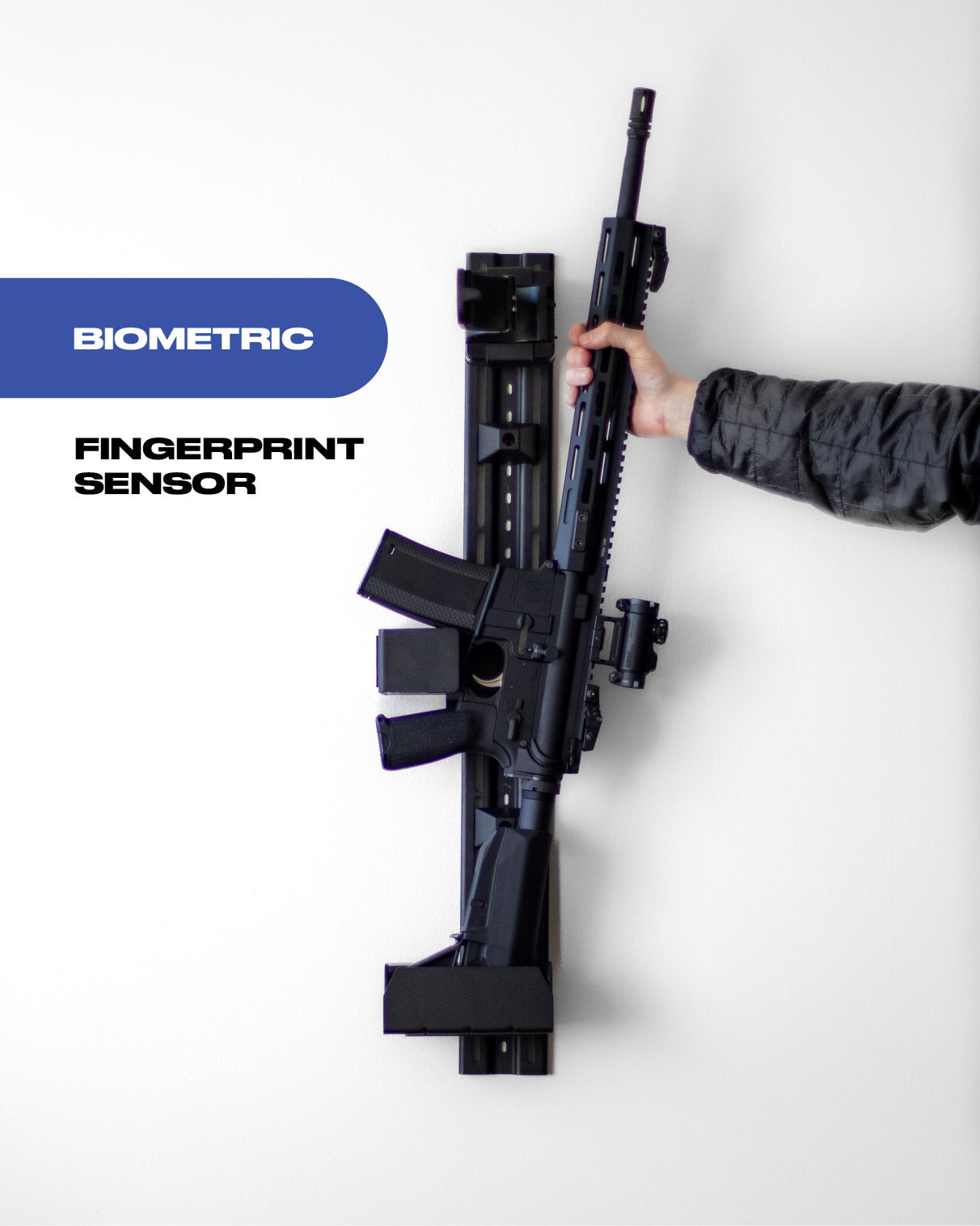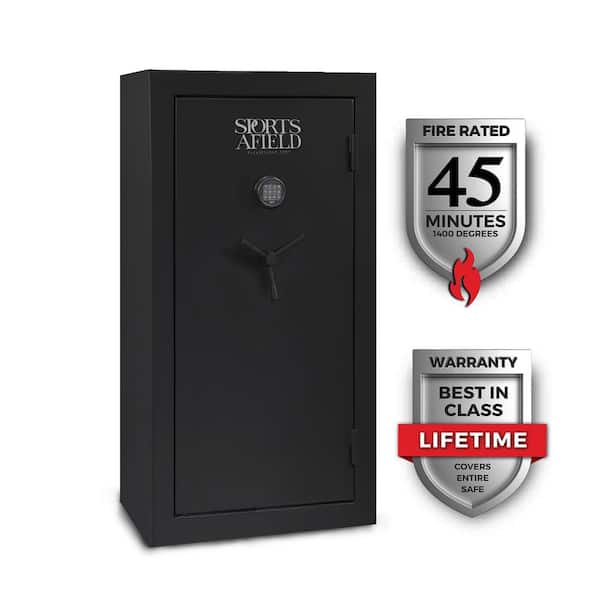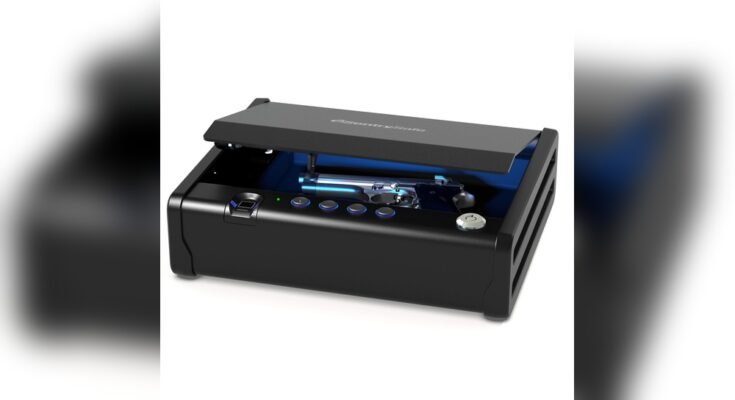Are you wondering if you can bolt down a biometric rifle safe to keep your firearms extra secure? You’re not alone.
When it comes to protecting your rifles, every detail matters. Bolting down your safe might seem like a simple step, but it can make a big difference in preventing theft or accidents. You’ll discover exactly how to do it, what tools you need, and the benefits of securing your biometric rifle safe to the floor or wall.
Keep reading to find out how to make your safe truly safe.

Benefits Of Bolting Down A Rifle Safe
Bolting down a biometric rifle safe adds many benefits. It keeps your firearms more secure and stable. This simple step improves safety inside your home. It also stops accidents and theft. Here are some key benefits of bolting down your safe.
Enhanced Security Against Theft
Bolting the safe to the floor or wall makes it hard to move. Thieves cannot carry the safe away easily. This adds a strong layer of protection. Your rifle and valuables stay in place. It lowers the risk of losing your firearms.
Prevention Of Unauthorized Access
Securing the safe limits access only to authorized users. It stops others from quickly tampering or stealing. The safe stays locked and steady. This extra step supports the biometric lock’s security. It helps keep your weapons safe from misuse.
Protection From Accidental Tipping
A bolted safe is stable and does not tip over. This reduces accidents, especially around children or pets. It prevents damage to the safe and your firearms. Stability keeps your home safer and your belongings secure.

Choosing The Right Location
Choosing the right location for your biometric rifle safe is very important. It affects security, ease of access, and the lifespan of the safe. Picking a good spot helps keep your firearms safe and ready when needed. Consider several factors before bolting down your safe.
Think about the floor material, how easy it is to reach, and the environment around the safe. These points can make a big difference in how well your safe works.
Assessing Floor Material
Check the floor where you want to bolt down the safe. Concrete floors are the best choice. They hold bolts tightly and prevent the safe from moving. Wood floors might not hold bolts well. They can wear out or break over time. Tiles can crack when you drill into them. Make sure the floor is strong and flat. This keeps your safe steady and secure.
Considering Accessibility And Concealment
Place the safe where you can reach it quickly in emergencies. Avoid spots that are hard to get to. At the same time, keep the safe hidden from plain view. A safe tucked away in a closet or behind furniture is harder to find. Balancing access and concealment helps protect your firearms from theft. It also lets you get to them fast when needed.
Avoiding Moisture And Environmental Risks
Pick a dry place for your safe. Moisture can cause rust and damage the locking system. Avoid basements or areas near water pipes. Keep the safe away from direct sunlight and heat sources. These can affect the electronics of the biometric lock. A clean, dry, and cool spot helps your safe last longer and work better.
Tools And Materials Needed
Securing a biometric rifle safe properly requires the right tools and materials. Using the correct items ensures the safe stays firmly in place. This section covers the essential tools and materials you need for bolting down your safe.
Types Of Bolts And Anchors
Select bolts and anchors based on the floor type. Concrete floors need heavy-duty expansion bolts. Wooden floors work well with lag bolts or wood screws. Use anchors that match the bolt size. This provides strong, reliable support for your safe.
Drill And Measuring Tools
A power drill is necessary to make holes in the floor. Choose drill bits that fit your bolts and anchors. A tape measure helps find the right spot for drilling. Use a pencil to mark these points accurately. Level tools ensure the safe stays even and steady.
Safety Gear And Accessories
Wear safety glasses to protect your eyes from dust and debris. Use gloves to keep your hands safe during drilling. Ear protection is important when using loud power tools. Have a flashlight nearby for better visibility in dim areas. Clean the workspace to avoid accidents and clutter.
Step-by-step Bolt Down Process
Bolting down a biometric rifle safe adds extra security. It stops the safe from moving or being taken. The process is simple and needs basic tools. Follow these steps carefully for a strong hold.
Preparing The Safe And Floor
Clear the floor area where the safe will sit. Check the floor is solid and flat. Remove any dust or debris from the bottom of the safe. Place the safe in the spot you want to bolt it down.
Marking Drill Points
Look under the safe for pre-drilled holes. Use a pencil to mark the floor through these holes. Double-check the marks line up with the safe’s holes. This step ensures the bolts will fit perfectly.
Drilling And Installing Anchors
Choose a drill bit that matches the anchor size. Drill holes in the floor at your marks. Clean the dust from the holes. Insert the anchors firmly into each hole. These anchors keep the bolts tight and secure.
Securing The Safe With Bolts
Put the safe back in place over the anchors. Insert bolts through the safe’s holes into the anchors. Use a wrench to tighten each bolt firmly. Check all bolts are tight and the safe does not move.
Common Challenges And Solutions
Bolting down a biometric rifle safe is important for security. It keeps the safe from being moved or stolen. Many face common challenges during installation. These problems can slow down the process and cause frustration. Understanding these challenges helps find simple solutions.
Dealing With Concrete Floors
Concrete floors are tough and require special tools. A regular drill cannot make holes in concrete. Use a hammer drill with a masonry bit to create bolt holes. Clean dust from holes before inserting anchors. Use heavy-duty anchors to hold the safe firmly. This prevents the safe from shifting or lifting.
Handling Wooden Or Carpeted Floors
Wood floors are easier to drill but need care. Avoid drilling too deep to protect wiring or pipes. Use wood screws designed for heavy loads. Carpeted floors can hide the safe’s base. Remove carpet padding where bolts go. This creates a solid surface for the safe to sit on.
Fixing Misaligned Bolt Holes
Misaligned bolt holes cause trouble during installation. Check the safe’s base and the floor carefully. Mark holes accurately before drilling. If holes do not line up, use a flexible bolt or washer. Adjust the safe’s position slightly to match holes. Proper alignment ensures bolts hold tight and safe stays secure.
Maintenance And Safety Tips
Maintaining your biometric rifle safe ensures it works well and stays secure. Regular care helps prevent problems and extends the safe’s life. Follow these simple tips to keep your safe reliable and safe.
Regular Inspection Of Bolts
Check the bolts that hold your safe in place often. Look for any signs of rust, looseness, or damage. Tighten loose bolts to keep the safe firmly attached. Replace any broken or worn bolts right away. This keeps your safe stable and hard to move.
Cleaning And Lubricating Locks
Clean the lock area with a soft cloth to remove dust and dirt. Use a small amount of lubricant made for locks to keep them smooth. Avoid using too much oil, which can attract dirt. Clean and lubricate regularly to prevent jams and ensure quick access.
Updating Biometric Settings
Update your fingerprint data often for better recognition. Remove old or unused fingerprints to keep the system accurate. Test the biometric scanner regularly to confirm it works well. Keeping settings updated helps avoid lockouts and keeps your safe secure.
Legal And Insurance Considerations
Securing a biometric rifle safe is more than a physical task. Legal and insurance rules also guide how to bolt down the safe. Understanding these rules helps keep you safe and avoid trouble.
Safe installation must follow laws and insurance terms. This section explores important points to consider before bolting down your biometric rifle safe.
Compliance With Local Firearm Laws
Every place has different laws about gun storage. Some require safes to be bolted down to prevent theft. Others may have rules on the type of lock or safe used. Check your local laws before installing your safe. This step ensures you follow the legal demands and avoid fines or penalties.
Impact On Insurance Policies
Insurance companies often need safes to be bolted down. This reduces the risk of theft and damage. Failure to secure the safe properly might lower or void your coverage. Inform your insurance provider about how you install the safe. This helps maintain full protection for your firearms.
Documenting Safe Installation
Keep proof of how and where you install the safe. Photos, receipts, and installation guides serve as good records. Documentation helps during insurance claims or legal questions. Store these papers safely for easy access when needed.

Frequently Asked Questions
Can I Bolt Down A Biometric Rifle Safe?
Yes, most biometric rifle safes can be bolted down for added security. Bolting prevents easy removal by thieves and enhances safe stability. Always follow the manufacturer’s instructions for proper installation and use appropriate anchors for your floor or wall type.
What Tools Do I Need To Bolt Down A Rifle Safe?
You typically need a drill, drill bits, bolts, washers, and a wrench. Use a masonry bit for concrete floors or a wood bit for wooden floors. Ensure the bolts are heavy-duty and fit the safe’s pre-drilled holes for secure anchoring.
Does Bolting Affect Biometric Safe Functionality?
No, bolting down a biometric safe does not affect its locking mechanism or fingerprint sensor. The safe’s biometric system operates independently from its anchoring method. Proper installation ensures security without compromising quick access to your firearms.
Are All Biometric Rifle Safes Bolt-down Compatible?
Most biometric rifle safes come with bolt-down options, but not all. Check the product specifications or contact the manufacturer to confirm. Bolt-down compatibility is crucial for securing your safe and preventing theft or unauthorized movement.
Conclusion
Bolting down a biometric rifle safe adds extra security and peace of mind. It keeps the safe stable and hard to move. Most safes come with pre-drilled holes for easy bolting. Make sure to use strong bolts and secure the safe to a solid surface.
This simple step helps protect your firearms from theft and accidents. Safety and quick access go hand in hand with proper installation. Always follow the manufacturer’s instructions for best results. A bolted biometric safe keeps your valuables both safe and accessible.
